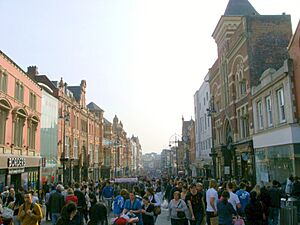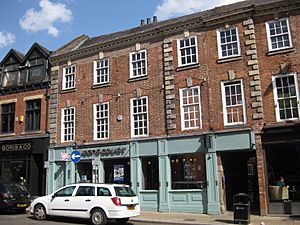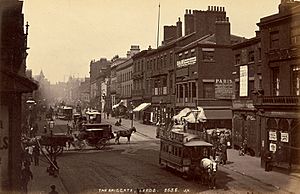Briggate facts for kids
Briggate is a main shopping street in Leeds city centre, England. It's a pedestrian street, meaning only people can walk there, not cars. For a long time, it was the most important street in Leeds. It had markets, shops, and homes for traders. You can still see many old buildings there, some from the 19th and early 20th centuries, including two theatres. Briggate is famous for its hidden yards and Victorian shopping arcades, which are like covered shopping streets. These were fixed up in the late 1900s. The street became a pedestrian-only area in the late 20th century.
Contents
History of Briggate
How Briggate Got Its Name
The name Briggate comes from two old words: brycg, which is Old English for bridge, and gata, which is Old Norse for a way or a street. So, Briggate means "bridge street." It's the road that goes north from Leeds Bridge, which is the oldest place to cross the River Aire.
When Leeds became a town in 1207, Briggate was its main street. Land on both sides of Briggate was divided into 30 "burgage plots." These were long, narrow strips of land given to traders to set up their businesses. This is why many of the shops and buildings on Briggate still have a similar width today. These traders also received farmland nearby. By the end of the 1200s, Briggate was a busy business centre, and markets were held there as the wool clothing industry grew. Leeds had a yearly fair on Briggate starting in 1322, and by 1341, there were two fairs.
Briggate in the 1500s
In 1533, people described Leeds as a "pretty market" town with four main streets: Briggate, Kirkgate, Swinegate, and Boar Lane. Leeds' oldest building is a three-story wooden house with a top floor that sticks out. It's in Lambert's Yard, just off Lower Briggate, and was built in the late 1500s or early 1600s.
Briggate in the 1600s
By the 1600s, Briggate was full of shops, offices, workshops, and homes, both grand and simple. Even though the land had been divided up more, the street still looked like it did in medieval times. It was wide enough for outdoor markets. Back then, the street ended in fields where the Headrow is now.
John Harrison, a rich cloth trader and an important official for the King, owned land north of Briggate. He built a large house at the north end and extended the street into what is now New Briggate. Harrison also paid for a new Moot Hall (a town meeting hall) and a market cross on Briggate in 1615. He also helped build the grammar school on New Street in 1624 and gave money for St John's Church, which opened in 1634.
The Battle of Leeds happened mostly along Briggate in 1643 during the English Civil War.
Briggate in the 1700s
In the 1700s, Briggate had the "shambles," which was a place where animals were slaughtered and meat was sold. One writer, Ralph Thoresby, said it was "the best-furnished Flesh Shambles in the North of England." The street was lined with beautiful three-story homes belonging to traders, often with gardens and fields behind them. Queen's Court (built in 1714) is an example of one of these old homes and businesses.
During the 1700s, Leeds grew a lot, and the population went from 6,000 to 25,000 people. This led to overcrowding. Many traders moved their homes away from Briggate, and their old properties were divided up into smaller shops or multiple homes. The narrow lanes and yards off the street became filled with small, crowded homes and workplaces.
Briggate in the 1800s
In the early 1800s, Leeds was described as a "smokey city, dull and dirty," with Briggate as its "one large street." But by 1889, it was called "one of the broadest, handsomest, and busiest thoroughfares in the North of England." Leeds' success in business led to many grand buildings being built, like the Grand Theatre on New Briggate in 1878.
The long, narrow plots of land on Briggate were perfect for building shopping arcades, which are covered walkways with shops. Thornton's Arcade was the first, opening in 1878. A company was formed to rebuild the old meat market area and the crowded homes around it. From 1898 to 1904, architect Frank Matcham created two new streets, Queen Victoria Street and King Edward Street, between Briggate and Vicar Lane. The buildings around these new streets included the Empire Theatre and the County and Cross Arcades.
In 1819, Alice Mann's bookshop and publishers on Briggate were thought to be a place where people discussed rebellious ideas.
Briggate in the 1900s
From the early 1900s, trams ran along Briggate until the Leeds tramways closed in 1959. In 1907, a Post Office Exchange building was built. It later became a Woolworths store, and an extra floor was added in 1920. In 1909, Marks and Spencer opened its first store at number 76. Their current store at number 47 was started in 1939 and finished after the war in 1951.
In 1910, Dyson's Jewellers added a special clock with a ball that dropped at exactly 1 p.m. This became a famous landmark known as the Time Ball buildings. In the 1930s, the Headrow became Leeds' main road, which caused some businesses on Briggate to struggle. The Debenhams department store opened in 1936 on the corner with Kirkgate, with unusual zigzag windows.
Sometimes, old buildings were knocked down for new developments. The Empire Theatre was demolished in the 1960s to make a very plain shopping area. However, the 1980s saw old buildings being fixed up. The Victoria Quarter, a group of three blocks between Briggate and Vicar Lane, was created in September 1990. It includes County Arcade, Cross Arcade, Queen Victoria Street, and King Edward Street.
In the 1990s, the plain shopping area where the Empire Theatre used to be was knocked down. A new glass front was added to connect the older buildings on either side, creating a Harvey Nichols store in 1997. Briggate became a pedestrian-only street in 1993, and in 1999, it was paved with York stone and granite setts (small paving stones). Lower Briggate and New Briggate still allow cars.
Briggate in the 2000s
The paving on Briggate was fixed up in 2007 for Leeds' 800th anniversary. In 2008, the Burton's Arcade, built in the 1970s, was knocked down at the south end of Briggate. This made way for the Trinity Quarter, which opened in March 2013. At the same time, the Market Street Arcade at the south end of Briggate closed for rebuilding. It got an extra floor, a glass roof, and new shops, reopening in 2012 as the Central Arcade.
Shopping Arcades
Leeds is well-known for its beautiful shopping arcades, especially those at the northern end of Briggate.
- Grand Arcade on New Briggate was built in 1897. It originally had two parallel covered walkways between Vicar Lane and New Briggate. It has a special clock by William Potts and Son with moving figures representing different parts of the British Empire.
- Thornton's Arcade was the first arcade in Leeds, finished in May 1878. It also has a clock by William Potts and Son. Below the clock, four life-sized wooden figures from the novel Ivanhoe strike a bell. These figures are Richard I, Friar Tuck, Robin Hood, and Gurth the swineherd.
- Queen's Arcade was named after the Queen and opened in 1889. It was built where the Rose and Crown Yard used to be. The entrance from Briggate was made bigger in 1895, and the arcade was refurbished in 1994. It has an upper shopping area with fancy cast-iron balconies, but you can't go up there anymore.
- County Arcade, designed by architect Frank Matcham, was finished in 1903. It looks very grand with its marble floors, detailed stonework, and elegant iron domes. It's part of the Victoria Quarter complex.
- Queen Victoria Street has been a covered street since 1990. It has the largest area of stained glass in Europe, designed by Brian Clarke, which forms its impressive roof. It's also part of the Victoria Quarter and is connected to County Arcade by Cross Arcade, which has a similar design.
- Central Arcade opened in 2012 where the Market Street Arcade used to be. This is the only arcade in Leeds that has shops on its first floor.
Theatres in Briggate Area
- Leeds Grand Theatre on New Briggate was rebuilt from 2004 to become a larger home for Opera North.
- Leeds City Varieties on Swan Street is one of the oldest music halls in the UK. It received money to be fixed up and restored, closing in January 2009 and reopening in September 2011.
- The Empire Theatre, designed by Frank Matcham, was on Briggate but was knocked down in the 1960s. The Harvey Nichols store now stands on its site.
Briggate's Yards
A special feature of Briggate is its "yards." These are more open spaces found behind the buildings on the main street. You can get to them through narrow alleys or covered passages. These yards are based on the old "burgage plots" and are usually long and narrow, as they were once working areas between buildings. Several of them used to have, or still have, inns (old pubs).
- Angel Inn Yard has the large 18th-century Angel Inn in a well-preserved Georgian square. This is where Joseph Aspdin first sold Portland cement, a type of cement.
- Blayd's Yard is close to Leeds Bridge and has old Georgian warehouses and cottages. A Leeds Civic Trust blue plaque here remembers famous printers.
- Hirst's Yard is an alley between Call Lane and Lower Briggate. It has an old warehouse from the early 1800s and the Whip Inn, which was a pub only for men until the 1980s.
- Lambert's Yard is a small square reached from a narrow alley on Lower Briggate. It contains the city's oldest building, which was once part of a larger 17th-century wooden building with upper floors that stuck out.
- Pack Horse Yard used to belong to the Knights Templar (a famous medieval order of knights) and has a cross from their old building. It has the Pack Horse Inn and another Civic Trust blue plaque remembering Joseph Aspdin, who invented Portland cement.
- Queen's Court is a yard behind a beautiful Queen Anne-style house that belonged to a cloth merchant. You enter through a central archway, and there are buildings from the 1700s and 1800s inside.
- Ship Inn Yard is between the inn and Queen's Arcade. Its size and location show how the original "burgage plots" were laid out.
- Turk's Head Yard had small homes for working-class people built in 1790. These were changed in 1880 into Whitelock's Ale House, a richly decorated Victorian pub with marble counters, engraved mirrors, and brasswork.
The back entrances to these yards were called 'low ins' or 'loins'. Some people think this is where the term Loiner (a person from Leeds) comes from, referring to people who would "hang around in the loins."
Images for kids






















